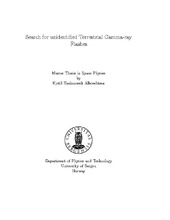Search for unidentified Terrestrial Gamma-ray Flashes
Master thesis
Permanent lenke
https://hdl.handle.net/1956/10301Utgivelsesdato
2015-06-01Metadata
Vis full innførselSamlinger
Sammendrag
Terrestrial Gamma-ray Flashes (TGFs) are the most energetic natural phenomena on Earth with possible energies above 40MeV. They consist of large amounts of energetic photons ( 10^17 to 10^19 ) produced in thunderstorms at 15-21km altitude. It is still an open question how often they occur and the exact production mechanisms for them. In this thesis we will use data from the World Wide Lightning Location Network (WWLLN) and the satellite RHESSI to investigate if there are fainter TGFs in existence that has yet to be identified. We will do this by extracting the light curves from RHESSI at the time of each WWLLN registered lightning flash in 2006 and 2012, and superpose these to see if there is a statistical increase in registered counts at the time of lightning. We discarded every lightning flash happening outside of RHESSI's field of view, and corrected for the travel time of gamma- rays to the satellite, as well as correcting for the systematic error in RHESSI's internal clock. We found that there is a statistical increase in counts at the time of light- ning, with an increase of sigma = 5.0 assuming a Poisson distribution. This indicated that there are weaker TGFs in existence that currently cannot be distinguished from the background. Further on we attempted to fit the fluence distribution of these possible weak TGFs to a power law, as has been suggested by Østgaard et al. [2012] and found that the exponent lambda; = 1.82. This is consistent with Østgaard et al. [2012] proposed hypothesis of a roll off at the lower end of the fluence distribution of TGFs, and supports the hypothesis that all lightning produce (or are associated with) TGFs.
